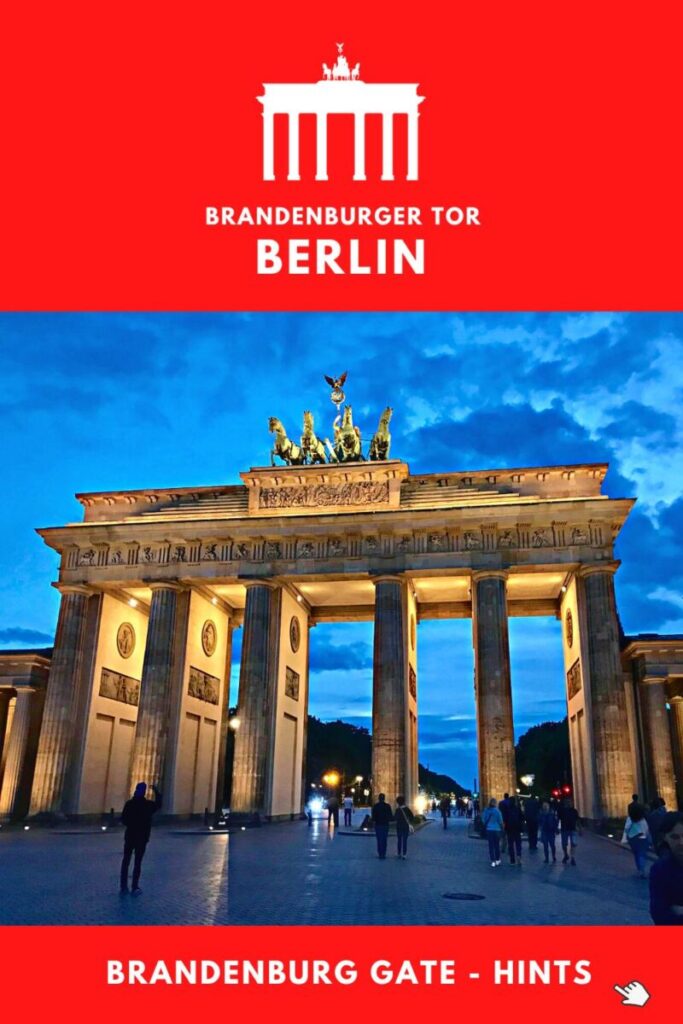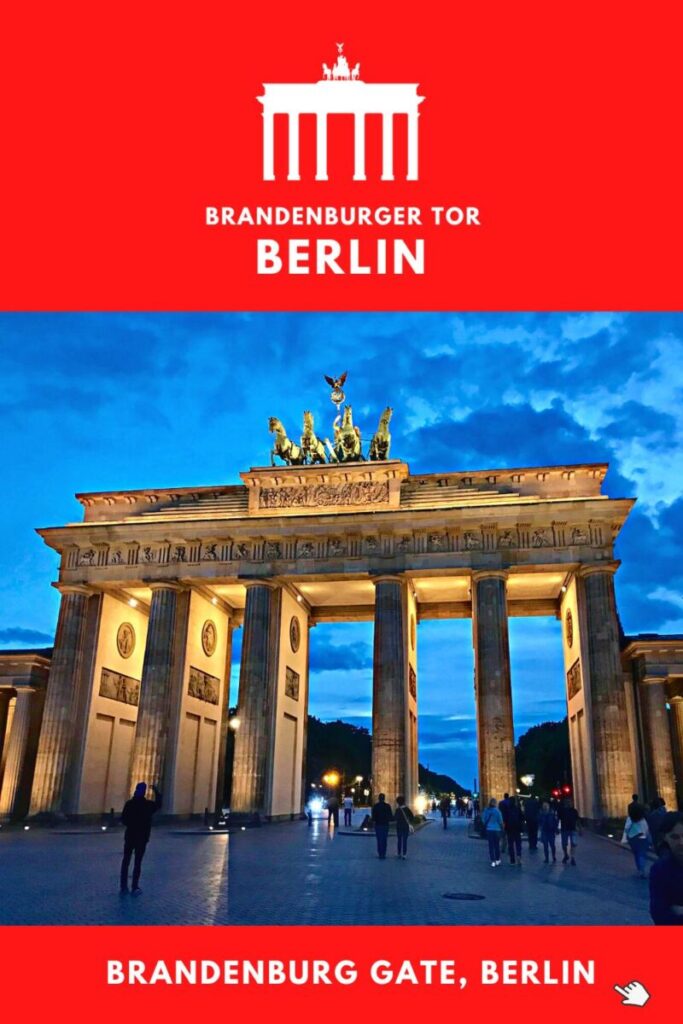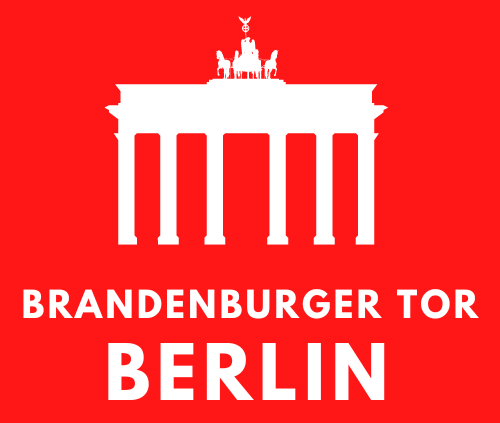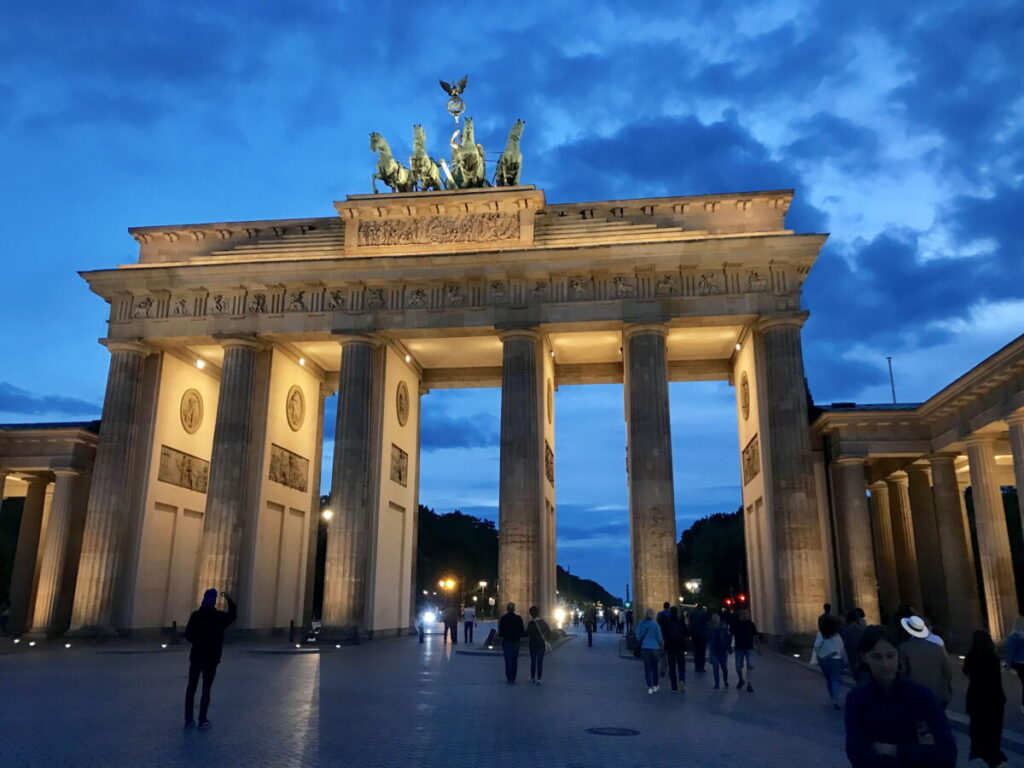
Brandenburg Gate Berlin
Peace gate, border gate, gate of reunion – this are attributes of the Brandenburg Gate. The Brandenburger Tor has experienced a lot over the course of history. But why was the gate built? Which rulers in German history have claimed the gate? And what secret is hidden in the roof of the archway? I give you all answers to these questions on this page. During my visit to Berlin I was impressed by the building and of course I took a few photos. Afterwards I discovered everything about the Brandenburg Gate. Here you get all information you need to know for your visit at the Brandenburg Gate.
Visit the Brandenburg Gate
Most tourists quickly take a photo of the mighty triumphal gate. Afterwards they leaving. But it’s worth taking a few more looks at the gate. You can discover numerous figures and creatures from Greek mythology. And there is also a secret attic that few people know about. Look closely and you can see the stairs leading there. But sorry, unfortunately visitors are not allowed to go into the attic. Take a lool at the Quadriga on top of the gate. This Quadriga has seen a lot in its life and was even kidnapped once. Let’s go on a journey around the well-known Berlin landmark!
Where is the Brandenburg Gate?
The famous gate is located in the heart of Berlin, almost right in the middle of the German capital. You can see that geographically as well as literally. Because the district is actually called Berlin-Mitte. The Brandenburg Gate is framed by two squares. The large Pariser Platz is the end of the boulevard “Unter den Linden”. The square is on the east side of the gate. West of the Brandenburg Gate is the Platz des 18. März. This leads on to Straße des 17. Juni, which once crosses the Großer Tiergarten.
Pariser Platz is the playground for tourists. The entire square is a pedestrian zone and is surrounded by various buildings. For example, you will find the famous Hotel Adlon on the south side. On the north side is the French embassy, among other things. Two small green areas with fountains give the square a cozy flair.
The Platz des 18. März is less appealing. Since motorized traffic is no longer allowed through the Brandenburg Gate, it has become a major traffic junction. That is why most of the visitors can be found on the other side of the gate. The sight from Pariser Platz is also nicer. Because the Quadriga, the team of horses at the top of the Brandenburg Gate looks towards Pariser Platz.
WHERE TO PARK YOUR CAR?
As central as the gate is, parking space is rather difficult. We have summarized the central parking options around the gate in an article here. You will also find the options for arriving by public transport.
-> Park the Brandenburg Gate
Triumphal gate with columns
Built on the Greek model, the Brandenburg Gate is an open triumphal gate made of sandstone. The architectural style is called classicism. The gate consists of a total of 12 pillars, 6 on the east side and 6 on the west side. The pillars are connected with walls. This is important for the statics of the gate. From each side you see 6 columns and therefore 5 passages. All passages are open for you today and you can walk through them. The middle passage is slightly wider. Until the end of the empire in 1918, only the emperor and his family were allowed to drive through the wide passage. On the walls of the walls inside, you can see reliefs. There are 2 of them on each wall, one on the front and one on the back. If you are interested in Greek history, you will recognize the saga of Hercules.
Relief on the roof
On the so-called Attica (on the outer roof projection), below the Quadriga, you will see another relief on the Pariser Platz side. Gods from Greek mythology are also depicted here. The relief is supposed to represent the train of the goddess of peace. You see the goddess of peace Eirene standing on a triumphal chariot. It is framed by various allegories, for example of friendship, unity, music or painting. The allegory of bravery is represented by Hercules with his club. He drives away envy and discord.
The entire relief is a symbol of peace. Originally, the Brandenburg Gate was a peace gate. Friedrich Wilhelm II had it built. Among other things, he “pacified” the provinces of the Netherlands and thus enlarged the Prussian Empire. That the peace was enforced by force is of course another matter. But at that time, the world conception was very different than it is today. A relief was originally planned for the back of the gate. Why it wasn’t executed is unknown.
Friezes on the entablature of the Brandenburg Gate
Above the columns you can see square friezes (images carved in sandstone). There are a total of 32 friezes on the east and west side of the gate. The individual friezes are about one square meter in size. And they represent something from Greek mythology again. This time it is the story of the dispute between the centaurs and the Lapiths. Centaurs are hybrids of humans and horses. Lapiths are a mystical people said to have lived in Greece. The myth says that the centaurs wanted to sexually assault the bride at a wedding of the Lapiths. But the Lapiths defeated the Centaurs. Symbolically, it is an attack of barbarism on civilization.
Gatehouses
The Brandenburg Gate is framed by two gatehouses. The gatehouses are also framed by smaller columns. There is a tourist information office in the southern gatehouse (to the left coming from Pariser Platz). Here you can get flyers, buy the Berlin Welcome Card (tourist ticket for public transport and attractions) or book a hotel room. In the north gatehouse is a room of silence. It was founded by committed citizens who take care of the space on a voluntary basis. You can just walk in during opening hours. In the deliberately very simply designed room you will find peace from the hustle and bustle of the big city. There is a statue in a niche between the actual gate and the gatehouses. Mars, the god of war, stands at the southern gatehouse near the tourist information office. Its counterpart on the north gatehouse represents the Greek goddess Minerva. She is a goddess of defense.
The Quadriga on the Brandenburg Gate
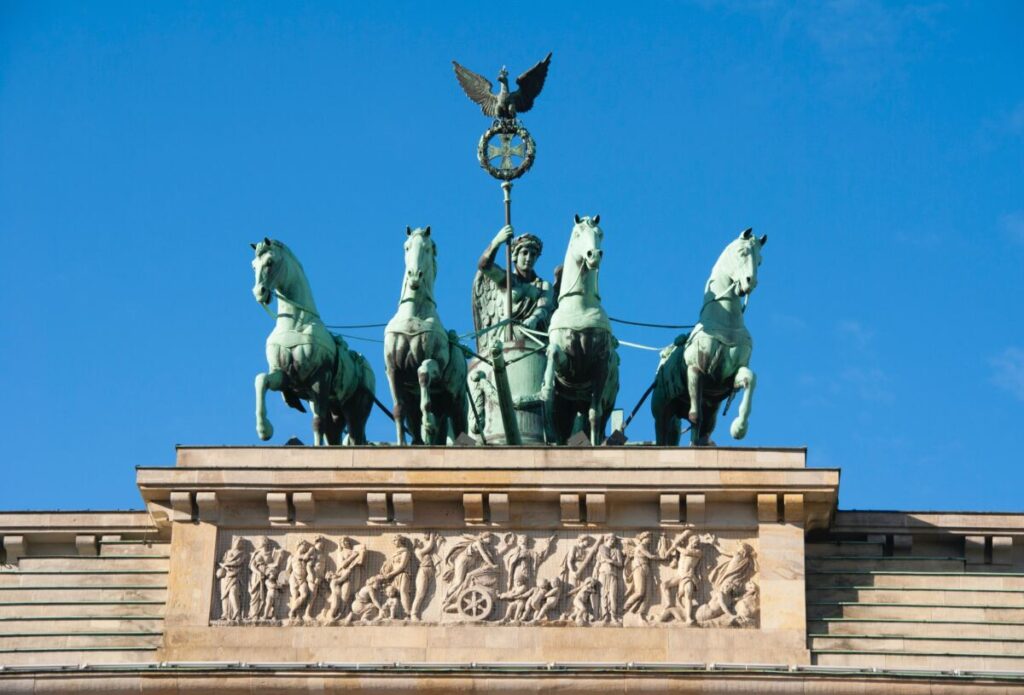
At the top of the Brandenburg Gate you can see the Quadriga. The figure consists of the goddess of victory, Victoria, standing on her chariot. It is pulled by 4 horses riding side by side. It was probably built based on the Mausoleum of Halicarnassus – one of the ancient 7 wonders of the world. The Quadriga has seen a lot over the years. It was kidnapped by Napoleon to Paris, almost completely destroyed in World War II and was one of the focal points of the New Year’s Eve celebrations in 1989/90. I tell you the whole story in this article:
—> The Quadriga on the Brandenburg Gate
Mystery in the Brandenburg Gate
The Brandenburg Gate also has a secret hidden in its roof: the Soldiers‘ Chamber ! Above the columns and below the quadriga is a kind of attic, also called an attic. Inside there is a room of about 250 square meters. It is 60 meters long, has three chambers, no windows and is about 5 meters high. The empty space was built for static reasons. Because it is not solid but hollow, it is of course lighter. This room was used in many different ways. Napoleon is said to have imprisoned and tortured prisoners here. At the end of the Second World War, the last soldiers of the Wehrmacht barricaded themselves here.
And in the days of the GDR there was a surveillance room here. At the New Year’s Eve celebrations in 1989, East and West Berliners were able to celebrate together for the first time in a long time. At that time, numerous people stormed the Brandenburg Gate and some also broke into the soldiers‘ chamber and destroyed the electronic surveillance systems. Today the chamber is closed and you cannot visit it. But you can see the entrance to the Soldiers‘ Chamber from the outside – if you know it’s there: at the top right of the outer wall of the gate (seen from Pariser Platz) there is a stone staircase that leads to a door. You can reach these stairs via the right gatehouse. In the Soldiers‘ Chamber there is also access to the roof of the Quadriga. Even if you don’t go in as a visitorcan, it’s still exciting to know what’s hidden in the goal.
Opening times and admission to the Brandenburg Gate
The Brandenburg Gate is always freely accessible and there is no entrance fee. Only if there is construction work, there may be restrictions.
Size of the Brandenburg Gate
To see the dimensions of the Brandenburg Gate in numbers, here are some technical data:
- Width: 62 meters
- Height (without quadriga): about 20 meters
- Height of columns: 13.5 meters
- Height of the Quadriga: about 6 meters
History of the Brandenburg Gate
To give you an understanding of the history of the Brandenburg Gate, I have put together a chronological overview here. So I won’t bore you with many details and you still get an insight into the very eventful history of the Brandenburg Gate:
Built by King Friedrich Wilhelm II.
1734 : A first city gate is built on the spot where the Brandenburg Gate stands today. However, it is still very simple.
1788 to 1791: The Brandenburg Gate is built. The architect is Carl Gotthard Langhans, who built it according to the plans of King Friedrich Wilhelm II. The model is the entrance to the Acropolis in Athens. The gate is built of sandstone and then painted white to make it look like marble. It is supposed to represent a gate of peace. Since the route leads to the city of Brandenburg (on the Havel river), the term Brandenburg Gate has become established.
1793: The Quadriga is placed on top of the Brandenburg Gate.
The Abduction and Return of the Quadriga/Foundation of the German Empire
1806/1807 : The Quadriga is carried off to Paris by Napoleon.
1814: The Quadriga is brought back to Berlin to great cheers from the German population. The Peace Gate becomes the Victory Gate.
1871: Great celebrations marking the end of the Franco-Prussian War and the founding of the German Empire.
The World Wars
1914-1918 : 1st World War.
1918/1919: November revolution and Spartacus uprising: The monarchy is to be ended and Germany is to become a republic. Revolutionaries entrench themselves on the Brandenburg Gate. The Quadriga is severely damaged.
1933: The National Socialists celebrate their seizure of power at the Brandenburg Gate. Over the next few years, numerous Nazi parades and marches took place at the gate.
1939-1945: World War II: The Brandenburg Gate and the Quadriga are badly damaged. The Quadriga literally melts. In the last days of the war, the last Wehrmacht soldiers are on the roof of the gate.


The division of Berlin
1950: Communist supporters of the FDJ almost completely destroy what is left of the Quadriga. The last original horse’s head is now on display in the Märkisches Museum Berlin.
June 17, 1953: Uprising in East Germany. Men hoist the German-German flag on the roof of the Brandenburg Gate. The uprising is crushed. Until reunification, June 17 is the „Day of German Unity“ and national holiday in West Germany.
1956/1957: Reconstruction of the Brandenburg Gate. East Berlin and West Berlin work together. With wise foresight, a copy of the Quadriga was made in 1942. So it can be well reproduced.
1961:Construction of the Wall: The Wall at the Brandenburg Gate is built on the Platz des 18.March (at that time: the square in front of the Brandenburg Gate). The gate belongs to East Berlin, but is in the restricted zone, where almost nobody is allowed in. The Wall is relatively low at this point and you can see the Brandenburg Gate quite well from West Berlin. There is even a viewing platform on the west German side.
Reunification
December 22, 1989: The Brandenburg Gate is opened in the course of the opening of the border.
New Year’s Eve 1989/90: Some revelers climb onto the roof of the Brandenburg Gate and again damage the Quadriga.
From 1990: The Brandenburg Gate is extensively renovated and there is regular maintenance work to this day.
Illumination of the Brandenburg Gate
The Brandenburg Gate is illuminated daily in the evening. Normally there is „only“ a normal light. It is also illuminated in color on special occasions. Such as the death of the Queen or declarations of solidarity with other countries. Once a year – usually in autumn – there is the Festival of Lights Berlin. Houses, squares and buildings all over the city are immersed in spectacular light shows. The light show at the Brandenburg Gate is one of the highlights. This creates incredible images.
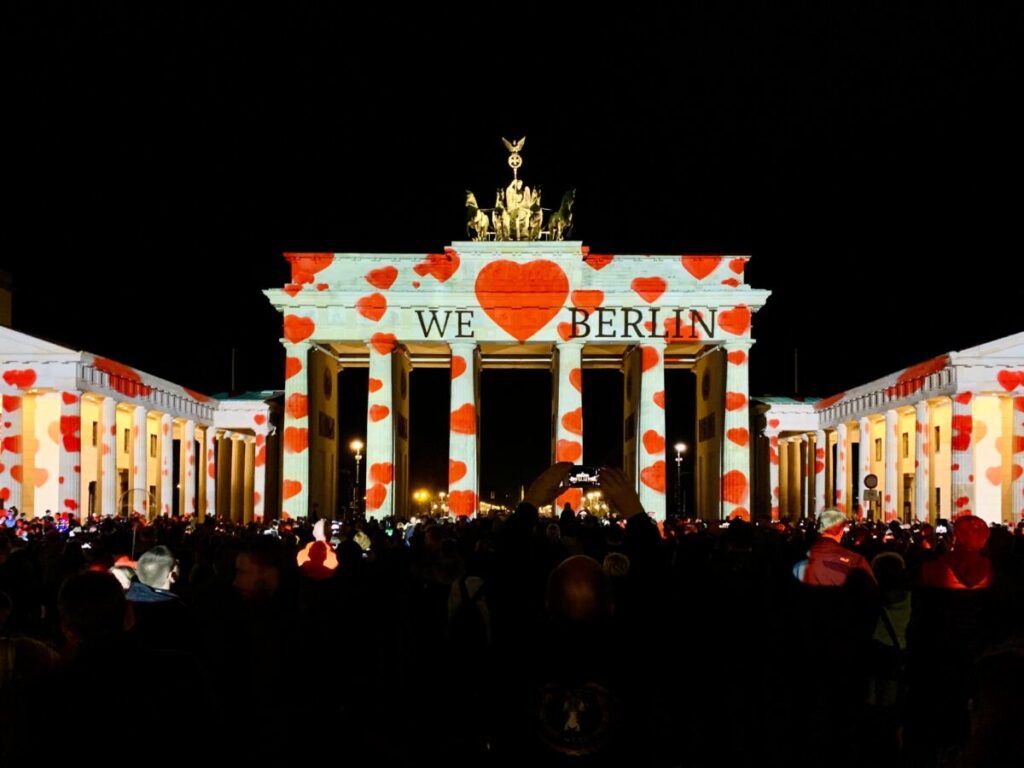
Festivals at the Brandenburg Gate
Numerous festivals and events take place throughout the year around the Berlin landmark. There is always a big celebration on October 3rd, the day of German unity. Then there is a town festival with many performances and activities for the whole family. New Year ’s Eve is always one of the biggest parties in Germany at the Brandenburg Gate. Well-known music bands play, there is a big show and of course fireworks. But there is always a lot to do during the year. For example, the Berlin Marathon starts at the gate and the traditional women’s run also starts here. The Festival of Lights Berlin takes place in October . A main show is at the Brandenburg Gate. Also the CSD takes place every year around the gate and draws attention to the rights of the LGBTIQ* community. You can find the exact dates for all events on the website of the city of Berlin .
Frequently asked questions about the Brandenburg Gate of Berlin
The Brandenburg Gate is always open. You can just go and see the gate.
No, the Brandenburg Gate is open to the public. You can visit it without admission. No ticket is necessary. You don’t have to register anywhere beforehand.
Yes, you can go straight to the big archway. It is also possible to walk through the 5 archways. A visit inside is not possible.
No. There is no way to visit the roof. The archway can only be seen from below.
After you can’t get in the gate or on the roof, about 15 minutes is enough. During this time you can visit the Brandenburg Gate from both sides and take a close look at everything.
No, you can’t. The area is reserved for pedestrians. After the turn you could drive through by car. Car access has been blocked since 2002.
Yes, that is possible.
The figure is called Quadriga. It depicts the goddess of victory, Victoria, on her chariot drawn by four horses. The word comes from the Latin and means that a wagon is pulled by a team of four – four draft animals side by side.
No. This rumor persists. But the Quadriga has always looked towards the city. She symbolizes entering the city as a goddess of victory.
Napoleon whisked the Quadriga to Paris after his victory in 1807. In 1814, after his defeat, she was brought back to Berlin.
There are a total of 3 Brandenburg Gates. One in Berlin, one in Potsdam and one in Kaliningrad, the former Königsberg.
ight next to the gate is the Holocaust Memorial . You can visit it for free at any time, ideally in combination with a visit to the Triumphal Gate. It is a few minutes‘ walk to the Reichstag . If you register in advance, you can get in for free and you can even go up into the Reichstag dome. A highlight in Berlin!
The Brandenburg Gate is definitely one of the highlights you should see in Berlin. It’s the most beautiful gate in the whole city. Also visit the most beautiful bridge in Berlin, the Oberbaum Bridge . Not far from the bridge, you should also take a look at the Molecule Man . Here you will find an overview of the Berlin sights .
And you should visit once in a lifetime the Leaning Tower of Pisa. We recommend the Lake Braies in the Dolomites, too
A note on our own behalf
Dear fellow bloggers, journalists and everyone else who reads this information in order to use it in any form. The entire article is protected by copyright, as is all other content on this website about the Brandenburg Gate. Before we published them here, they were nowhere else to be found on the internet. Therefore, we can very quickly identify any plagiarism and „copycats“ as a source. Copying the text is illegal anyway. However, if you use individual data from this website, it is journalistic honor to link this website.
Brandenburg Gate Potsdam
In addition to the Brandenburg Gate in Berlin, there are two other gates that have the same name. One is not far from Berlin and is in Potsdam. It is about 20 years older than the gate in Berlin. It was built by King Frederick II, also known as Frederick the Great. After the victory of the seven-year war against Austria (it was about the territory of Silesia), he had the gate built. Prussia’s time as a major European power began. As a victory gate, it was built according to the Roman model. The front and back are designed slightly differently.
The side facing the city was built by the architect Carl von Gontard. The back was designed by his student Georg Christian Unger. On the gate you can see war and victory trophies. The goal has three passes today. The small, lateral passages were only created later, as additional passages for pedestrians. Oh, this gate got its name – just like the gate in Berlin – because it leads to the city of Brandenburg an der Havel.

Brandenburg Gate Kaliningrad (Koenigsberg)
There is another Brandenburg-Gate in Kaliningrad, Russia. Kaliningrad used to be called Königsberg and belonged to Germany, more precisely to East Prussia. After 1945 it became Russian. The gate is built in neo-Gothic style and leads to a small town on the Vistula Lagoon, which used to be called Brandenburg, hence the Brandenburg Gate. Today this city is called Ushakovo. The gate was rebuilt in 1860 to protect the city. But there has been a city gate since 1657. The gate therefore primarily had military purposes. Loopholes were installed and there was a protective ditch with a drawbridge. In April 1945, the city was also the scene of fierce fighting, which took place at the Brandenburg-Gate, among other places. Today it is a memorial. Trams and cars can pass under the gate.

Remember these Berlin hints
Do you also want to go to Berlin? Then remember these hints with an email, WhatsApp or a pin on Pinterest. So you can find that good information again when you have time. You can also give the tip to your friends – share the post on Facebook or send it as an email or WhatsApp. Simply click on the symbol of your choice:
